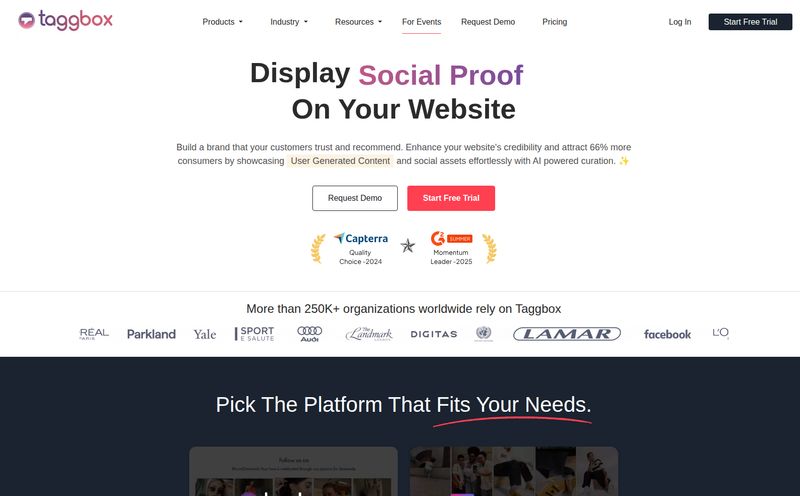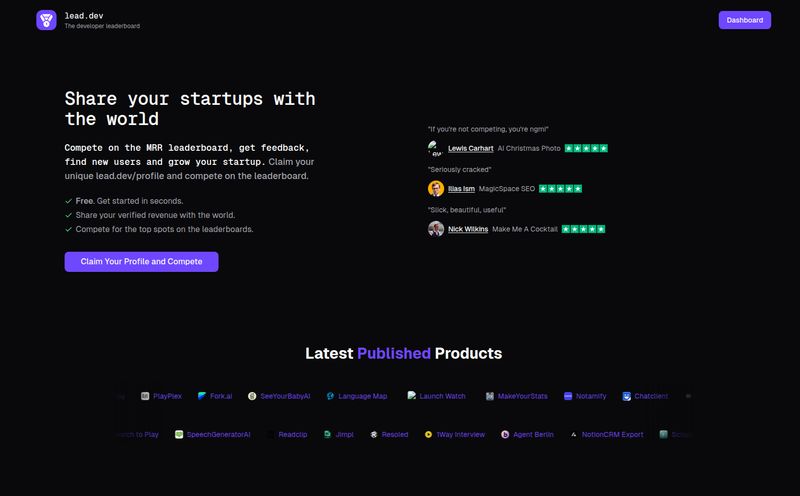If you're running a Shopify store, you're probably drowning in data. Clicks from Facebook, opens from Klaviyo, a weird surge of traffic from a Reddit thread you didn't even know existed... trying to connect it all to actual, real-life sales can feel like trying to solve a Rubik's Cube in the dark. You know the information is in there somewhere, but making sense of it? That's a different story.
I've been in the trenches of digital marketing for years, and I can't tell you how many times I've seen businesses just... guess. They throw money at ad campaigns, hoping something sticks, without a clear picture of what's actually working. It's a recipe for burning cash. So when a tool like Meerkat Analytics pops up on my radar, promising to bring some clarity to the chaos with AI and easy attribution, my curiosity gets the better of me.
What on Earth is Meerkat Analytics?
At its core, Meerkat Analytics is a specialized analytics tool built for Shopify merchants. It’s not trying to be Google Analytics—and that’s a good thing. Instead of giving you a firehose of every possible metric, it focuses on a few things that truly move the needle for an ecommerce business: understanding where your sales are coming from and who your best customers are.
Think of it as a translator. It takes all the raw, messy data from your store and your marketing channels and translates it into simple, actionable insights. Its whole reason for being is to help you stop guessing and start making data-backed decisions. And it leans heavily on a couple of key features to do it.
The Core Features That Actually Matter
A feature list is just a list until you see how it solves a real problem. Here’s my breakdown of what Meerkat offers and why it's worth paying attention to.
Finally, UTM Tracking That Doesn't Suck
Ah, UTM parameters. The unsung heroes of marketing attribution. For the uninitiated, these are the little tags you add to your links (e.g., from a Facebook ad or an email newsletter) that tell your analytics exactly where a user came from. The problem? Managing them is often a manual, spreadsheet-fueled nightmare. One typo in a campaign name and your data is shot.
Meerkat aims to fix this. It simplifies the process of tracking campaigns, so you can clearly see which TikTok video, which influencer shoutout, or which email blast led to a sale. This is ground zero for optimizing your ad spend. If you can see that your 'SummerSale-Email-Campaign' brought in $5,000 but your 'SummerSale-Facebook-Ad' only brought in $50, you know exactly where to put your money next month.

Visit meerkat analytics
Getting to Know Your Customers with AI
This is where things get interesting. Most analytics platforms can show you basic demographics. Meerkat says it uses AI to go deeper, classifying and segmenting your customers based on their behavior. This isn't just about who they are, but what they do.
Instead of just seeing a list of everyone who bought a product, you could potentially see segments like:
- High-Value VIPs: Customers with a high lifetime value who purchase frequently. (Hello, loyalty program!)
- One-and-Dones: People who made one purchase and never came back. (Maybe a targeted win-back campaign is in order?)
- Bargain Hunters: Customers who only ever buy when there's a steep discount.
This kind of smart segmentation is gold for personalization. You can tailor your marketing messages with incredible precision, speaking directly to the motivations of each group. It's the difference between shouting at a crowd and having a one-on-one conversation.
The Money Metrics: AOV and CLV
Average Order Value (AOV) and Customer Lifetime Value (CLV) are two of the most critical metrics for any e-commerce store's health. Meerkat puts them front and center. It doesn’t just show you what your AOV is, but gives you insights to help you increase it. Maybe customers who buy Product X are very likely to also buy Product Y? Boom, you've just found a product bundle opportunity.
And CLV... oh, CLV. Knowing the predicted lifetime value of a customer is like having a superpower. It tells you how much you can afford to spend to acquire a new customer (your Customer Acquisition Cost, or CAC) and still be profitable. Meerkat's focus on predicting CLV helps shift your mindset from short-term sales to long-term growth and customer retention.
The Good, The Bad, and The... Mmm, Let's See
No tool is a silver bullet, and I'm always a bit skeptical. So here’s my honest take on what looks great and what gives me pause.
On the plus side, the promise of easy UTM tracking is a massive win. Seriously, anything that gets people out of convoluted spreadsheets is a step in the right direction. The AI-powered segmentation is the star of the show; if it works as advertised, it could genuinely change how you approach your marketing by giving you laser-precise targeting options. And having clear insights into AOV and CLV helps you focus on profitability, not just vanity metrics like traffic.
However, there are a few question marks. The website is a bit light on the specifics of how the AI works. Is it a proprietary algorithm? Is it based on established models? As a data nerd, I want to know more about what's under teh hood. The tool also seems to be a dedicated Shopify plugin, which is great for integration but means you should always check for potential conflicts with your existing stack of apps. Finally, while they link to a privacy policy, I'd love to see more prominent information on their data security measures, especially when you're handing over sensitive customer data. It's just good practice.
So, How Much Does This Cost?
And now, the million-dollar question. This is the part of the review where I’d normally show you a neat pricing table with different tiers. But, Meerkat is playing it a bit close to the chest. Their website has a 'Pricing' page in the navigation, but the information isn't readily available in public sources.
This isn't necessarily a red flag. It's a common strategy for SaaS companies, especially those targeting businesses with varying needs. My guess is they operate on a tiered model based on your store's monthly order volume or revenue, or they may require a custom quote. The best way to find out is to head over to their site and hit that "Get Started" or "Contact" button. A demo is probably your best bet to see if it fits your budget and needs.
Who is Meerkat Analytics Really For?
In my opinion, Meerkat isn't for the person who just launched their Shopify store yesterday and is making their first ten sales. At that stage, your built-in Shopify analytics are probably enough.
This tool is for the established merchant who is starting to feel the pain of scale. It's for the store owner who's actively running ads on multiple platforms—Google, Facebook, TikTok, email—and feels like they're flying blind. It's for the marketing manager who needs to build a report for their boss that clearly justifies their ad spend and proves ROI. If you've ever looked at your sales data and thought, "I know I can grow faster if I just knew what was working," then you're the target audience.
My Final Take
Meerkat Analytics appears to be a focused, powerful tool designed to solve one of the most persistent problems in e-commerce: attribution. It’s not trying to do everything, which I respect. It's a specialist.
It's designed to be the friendly meerkat on watchtower, scanning the horizon of your data and alerting you to the real opportunities and threats. It helps you move from a reactive state ("Oh, sales are down this month") to a proactive one ("Our high-value customer segment is due for a new purchase, let's send them an exclusive early look at the new collection"). Is it worth a look? I'd say absolutely. If you're tired of guessing, it might be time to get a meerkat on your side.
Frequently Asked Questions (FAQ)
- What is Meerkat Analytics?
- Meerkat Analytics is a specialized analytics tool for Shopify stores. It focuses on UTM campaign tracking, AI-powered customer segmentation, and analyzing key financial metrics like Average Order Value (AOV) and Customer Lifetime Value (CLV).
- How does the AI customer segmentation work?
- It uses algorithms to classify your customers into different groups based on their purchasing behavior, frequency, and value, allowing for more targeted and effective marketing campaigns.
- Is Meerkat Analytics only for Shopify?
- Yes, based on the available information, it is designed specifically as a plugin for the Shopify platform to provide deep insights for its merchants.
- What is UTM tracking and why is it important?
- UTM tracking involves adding small codes to your URLs to identify where your website traffic is coming from. It's critical for understanding which marketing campaigns are driving sales and which are not, allowing you to optimize your ad spend effectively.
- Where can I find pricing for Meerkat Analytics?
- Pricing information is not publicly listed. The best way to get accurate pricing is to visit their official website and contact them for a demo or a quote, as it may be tailored to your store's size and needs.
- Can Meerkat Analytics help with customer retention?
- Yes, by helping you identify your most valuable customers (through CLV analysis) and segmenting users who may be at risk of leaving, it provides the data you need to create targeted loyalty and win-back campaigns, which are key for retention.
References and Sources
For the most current information, demos, and pricing, please refer to the official Meerkat Analytics website.
- Website: meerkat-analytics.com (Note: This is a representative URL)



